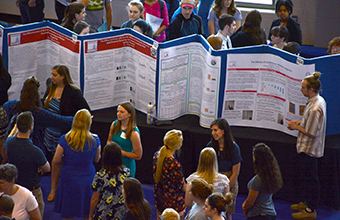College of Arts and Sciences Newsroom

Stander Symposium Co-chairs
The Brother Joseph W. Stander Symposium is the University of Dayton's annual showcase of students' academic achievements. This year, the program is co-chaired by two College of Arts and Sciences faculty members ? Joel Whitaker, professor in the department of art and design, and Shannon Driskell, professor in the department of mathematics.
The Stander Symposium is a daylong event in which undergraduate students from all University disciplines, as well as many graduate students, are invited to present research, scholarship and artistic accomplishments. The event has been held for more than 25 years, with a goal to recognize the importance of student research and accomplishments, as well as faculty mentorship.
The event will take place from 8 a.m. to 5 p.m. Wednesday, April 5, at various campus locations, where students will present their research in a poster format or through oral presentations. Later that evening the Stander closing reception alongside the Horvath Annual Juried Exhibition awards presentation will take place in the department of art in design on the second floor of Fitz Hall. The Horvath Exhibition is an event in which art and design students’ creative works are judged by an outside juror.
Whitaker and Driskell have previous experience with the symposium that placed them in this year’s co-chair roles. Driskell was the co-chair of last year’s event after previously working on the Stander Symposium steering committee. Whitaker served on the task force to update and re-invent the vision statement of the symposium surrounding its 25th year.
While much of the logistical and planning support comes via the University Provost’s Office, Whitaker and Driskell guide a committee of faculty for the program.
“The Provost’s Office and its staff are the backbone of the event; we’re really the faculty voice for the symposium in our role,” Driskell said.
In addition to faculty and staff, the program’s committee includes two student voices, Margaret Schaller, a senior human rights and international studies major, from Liberty Twp., Ohio, and Mateo Chavez, a junior economics and operations management major from Glen Ellyn, Illinois.
The committee is specifically focused on making the symposium more streamlined and focused this year.
The committee’s goals have come from the vision statement created by the Stander task force to better promote the symposium, increase undergraduate student engagement, graduate school engagement and participation, and advertising and introducing the event to new faculty at the University.
“The symposium is an opportunity to highlight not only the research that students do but really applaud the work that faculty do in mentoring and educating students,” Whitaker said.
Whitaker and Driskell echo one another in stating that it is an advantage to the College to have two chairs from differing departments to lead faculty engagement with the event.
“It allows us to encourage not only our own students, but students in our departments and other faculty members and students, to get involved with showcasing their work and achievements,” Driskell said.
Whitaker adds the opportunities through the symposium allow students to learn applicable skills outside of their classroom work.
“Having an undergraduate symposium professionalizes various capstone courses,” he said. “It raises the expectations of courses, as students’ projected outcomes become public when they present not only to their peers but to people outside of their peer group.”
The symposium gives students an opportunity to become better able to synthesize research and provide context for a general audience to gain understanding of their work. Students have to be able to present simply what they are doing, why they are doing it and how they are accomplishing their goals in that research.
“Students can really explore topics within their discipline, and they can also explore topics outside of their area to broaden their interest and knowledge within our University setting,” Driskell said.
Driskell adds that the mission of the symposium is congruent with the University’s mission.
“The Marianist tradition really lies in education through community, and the Stander Symposium is a way for the University to uniquely celebrate our community of learners in this day,” she said.
The symposium will end with the event’s keynote speaker at 7 p.m. Thursday, April 6, in Kennedy Union ballroom. Lisa Randall, a Harvard University professor and author of Dark Matter and the Dinosaurs, will discuss her work with particle physics and cosmology as well as her experiences writing a libretto for Hypermusic Prologue: A Projective Opera in Seven Planes.
“I think our keynote speaker will speak to the connection in the way that artists and scientists think, solve problems and make their research visible,” Whitaker said.
The keynote speaker will speak to the mission of the Stander Symposium and the importance of interdisciplinary learning.
“It’s a perfect keynote to end on because it exemplifies interdisciplinary research and a holistic way to approach knowledge, as we know that knowledge is very connected and not separated into different compartments and disciplines,” Driskell said.
- Alex Burchfield ’16, communication assistant, College of Arts and Sciences
